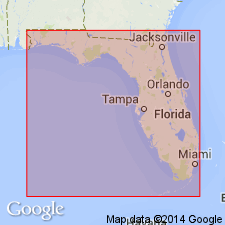
- Usage in publication:
-
- Croatan beds
- Modifications:
-
- Original reference
- Dominant lithology:
-
- Sand
- AAPG geologic province:
-
- Atlantic Coast basin
Summary:
Pg. 209, 213-216. Croatan beds. For the beds found along estuary of Neuse River, North Carolina, the local Indian name of Croatan beds may be used. [Fossils listed.] The Croatan beds are obviously newer than those of the Waccamaw, yet when compared with the admitted Pleistocene beds of South Carolina, such as those of Simmon's Bluff, the presence in the Neuse of 41 out of 96 species that have not been known later than Pliocene forbids us to regard the fauna as later than Pliocene.
Present in coastal plain of North Carolina north of Hatteras axis.
Source: US geologic names lexicon (USGS Bull. 896, p. 545).
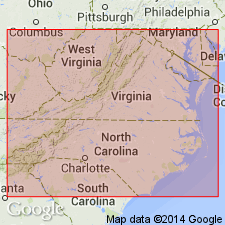
- Usage in publication:
-
- Croatan sand*
- Modifications:
-
- Revised
- Age modified
- AAPG geologic province:
-
- Atlantic Coast basin
Summary:
After a study of typical Croatan deposits and their fossils, author discovered that beds of both Pliocene and Pleistocene age had been included in the formation. The name is here restricted to the Pliocene beds, which consist chiefly of coarse ferruginous, more or less fossiliferous sand rising to an observed maximum height of about 4 ft above the beach, and are unconformably overlain by Pleistocene beds. Name changed to Croatan sand as unit is all one lithology.
Source: GNU records (USGS DDS-6; Reston GNULEX).
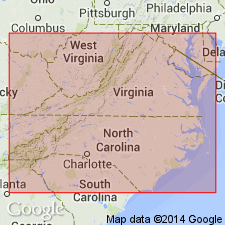
- Usage in publication:
-
- Croatan sand*
- Modifications:
-
- Principal reference
- AAPG geologic province:
-
- Atlantic Coast basin
Summary:
Croatan sand of U.S.G.S. usage is of Pliocene age. Dall's original material from "Croatan beds" is mixture of Pliocene and Pleistocene and was probably collected along river for a distance of several miles. No Pliocene is exposed in bluffs of Neuse River nearest Croatan itself, so that type section for Croatan sand cannot be recognized there. Best section of Pliocene in region is exposed on property of Mr. Hastings on right bank of Neuse River, 2 mi below James City, Craven Co., and this might be regarded as type section of Croatan sand.
Source: GNU records (USGS DDS-6; Reston GNULEX).
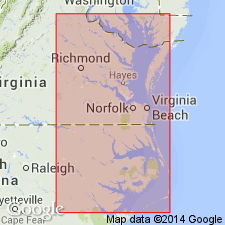
- Usage in publication:
-
- Croatan Formation*
- Modifications:
-
- Revised
- Age modified
- Areal extent
Summary:
Croatan Formation assigned to Chesapeake Group as uppermost of six named formations. Geographically extended into southeasternmost VA from eastern NC. Age changed from early Pliocene to late Pliocene and early Pleistocene.
Source: GNU records (USGS DDS-6; Reston GNULEX).
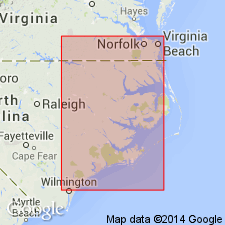
- Usage in publication:
-
- Croatan†
- Modifications:
-
- Abandoned
- AAPG geologic province:
-
- Atlantic Coast basin
Summary:
Croatan Formation abandoned. Its lower rocks replaced by Chowan River Formation (new name) and its upper rocks by James City Formation.
Source: GNU records (USGS DDS-6; Reston GNULEX).
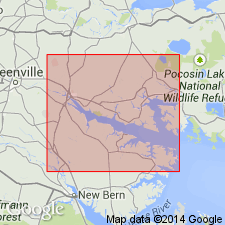
- Usage in publication:
-
- Croatan Formation
- Modifications:
-
- Overview
- AAPG geologic province:
-
- Atlantic Coast basin
Summary:
Croatan Formation in Beaufort Co., east-central NC, is a 1- to 25-m-thick complex sequence of very shelly sands deposited in coastal system associated with barrier islands, tidal-inlet channels, and shallow nearshore marine shelf environments. Unconformably underlies unnamed quartz sandy clays, muds, and peats. Unconformably overlies Pliocene Yorktown Formation. Age is early Pleistocene.
Source: GNU records (USGS DDS-6; Reston GNULEX).
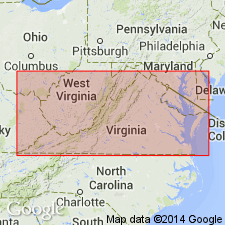
- Usage in publication:
-
- Croatan
- Modifications:
-
- Not used
- AAPG geologic province:
-
- Atlantic Coast basin
Summary:
James City was initially called Croatan beds by Dall (1892). According to Hazel (1983), the Croatan is an earlier valid usage synonymous with the James City, since MacNeil (1938) designated a type section for the Croatan. However, the James City "has acquired prevailing usage" and is used here. The James City, upper Waccamaw, and upper Caloosahatchee faunas were victims of the same extinction event, which has been dated by Lyons (1991) as pre-1.5 Ma. The younger dates (1.1 and 1.4 Ma from coral) of McCartan and others (1982) are either minimum dates or came from the overlying Bermont. This author assigns the James City to the late Pliocene based on the Krantz (1991) oxygen isotope model, which predicts ages of 1.9 to 2.1 Ma. These youngest beds of the Yorktown depositional basin are known only from NC.
Source: GNU records (USGS DDS-6; Reston GNULEX).
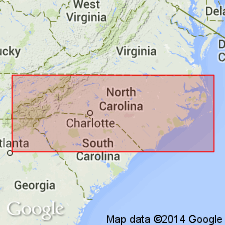
- Usage in publication:
-
- Croatan Formation
- Modifications:
-
- Geochronologic dating
- Age modified
- AAPG geologic province:
-
- Atlantic Coast basin
Summary:
The material analyzed in this study consisted of long-ranging, nondiagnostic fossil shells and sandy, glauconitic limestones. Phosphatic materials gave inconsistent results. The age of deposition for each unit was assigned by comparing 87Sr/86Sr results with the seawater strontium curve. Analysis of Yorktown and Croatan Results enabled the authors to define the age of these units precisely and to suggest slightly younger ages than those base on detailed paleontologic studies. At Aurora, the Yorktown gives a latest Pliocene-earliest Pleistocene age, while the Croatan gives a middle Pleistocene age.
Source: GNU records (USGS DDS-6; Reston GNULEX).
For more information, please contact Nancy Stamm, Geologic Names Committee Secretary.
Asterisk (*) indicates published by U.S. Geological Survey authors.
"No current usage" (†) implies that a name has been abandoned or has fallen into disuse. Former usage and, if known, replacement name given in parentheses ( ).
Slash (/) indicates name conflicts with nomenclatural guidelines (CSN, 1933; ACSN, 1961, 1970; NACSN, 1983, 2005, 2021). May be explained within brackets ([ ]).

